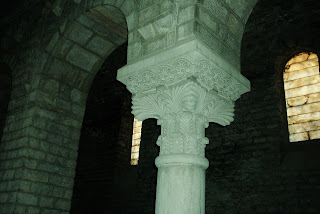The old Benedictine monastery of Santa Maria de Ripoll was founded in 879 and completed in 1046. It has been off the beaten path, away from coastal invasion areas, but near one of the main cross-Pyrenees trade and less devastating routes. The church is Romanesque: stout columns, massive naves, shallow buttresses on the outside because the height was lower, less force thrusting out from the walls, windows small, portals with sculpturing, molding, cushion or other capitals, towers, rounded arches, all preceding the lofty Gothic.
Worn figures still show coloring from original paint, and black faces and hands are not unusual. It interests me because of the number of Black Madonnas in Europe, some easily explained as ground mold after long burying, others not so explained. There apparently is a tradition of the Black Jesus in Italy, recently in a nativity display in Verona, that caused some discomfort among White Christmas folk (search) and an ancient one at Lucca, see http://austriaroadways.blogspot.com/2009/11/linz.html. Here, see also black angel faces. What explanation?
This circular dropped chandelier is reminiscent of Barbarossa's chandelier in Aachen, Germany, possibly, see http://www.sacred-destinations.com/germany/aachen-cathedral,
connections to Charlemagne, and another is at Vorden's Church, Germany, see http://www.germanyroadways.blogspot.com/#!http://germanyroadways.blogspot.com/2010/11/vorden-worlds-best-church-chandelier.html; when we post for Roncesvalle, I think we have a photo of a similar chandelier inside a building we could not enter, a Charlemagne-Roland memorial.
Then, eyes up for the capitals: When we are long gone, who will know the lives we led. These people are also gone, and we see visually the lives they led, the struggles, the battles. Our remembrances are on transitory film, in the cloud, on photo cards, albums go in the trash as people scan grandaddy into the eternal not so much eternal machine.
Romanesque capital, is that God or Christ over Bishop and King?
Patterned cut-out ironwork, Catalan flag upended (so it appears), whose grave, Santa Maria de Ripoll, Spain. Buried here are Wilfred the Hairy, Raymon Berenguer III, Ramon Berenguer IV, Bernat Tallaferro, Count of Basalu, Radulf, Abbot of Ripoll, son of Wilfred. Unknown location but there are, apparently, Sunifred II, Count of Barcelona (a/k/a Sunyer). Miro I, Count of Barcelona, and Ramon Berenguer I, Count of Barcelona.
On closer look, this looks like an animal head, and a tail. Help out here. What is this?
And the capitals continue to show ordinary people, here one with a distinctly Phrygian Cap, the pullover cap with excess fabric pulled forward ..
Eyes down now. Watch for the bases of fine capitals, this at the base of some fine red marble: animals ferocious, great tails.
Portals are fabulous -- an entire blog could examine the extent of these carvings. Here, we like the carvings, but focus also on the ironwork, the swirl, curl pattern, almost Celtic. There is a rosette shape at the top. These were not just decorative: this kind of ironwork held the thick slats of the doors together against invasion, at least for a while under stress.
This capital appears to show a king, with crown and sceptre, but -- look closely -- is he being mooned?
This would not be unusual, as the practice was well entrenched by the middle ages, see http://www.slate.com/blogs/browbeat/2012/06/27/mooning_a_history_when_did_people_start_baring_their_butts_as_an_insult_.html. Find mooners in Germany, at http://www.germanyroadways.blogspot.com/#!http://germanyroadways.blogspot.com/2011/03/luneberg-and-german-exceptionalism.html; and at the Sistine Chapel, above the altar, ceiling, search for images -- God dividing night from day. There you are.Divine moon.
.
 Monastery, Santa Maria de Ripull, front view, Catalan Flag
Monastery, Santa Maria de Ripull, front view, Catalan Flag Figure of Christ, black skin, Santa Maria de Ripoll.
Figure of Christ, black skin, Santa Maria de Ripoll. Romanesque Chandelier, circular candle-lit form, pendants, Saint Mary of Ripoll, Spain
Romanesque Chandelier, circular candle-lit form, pendants, Saint Mary of Ripoll, Spain Romanesque font or urn? Looking for notes, alabaster? Santa Maria de Ripoll Spain
Romanesque font or urn? Looking for notes, alabaster? Santa Maria de Ripoll Spain Romanesque ironwork, chapel, Santa Maria de Ripoll, Spain
Romanesque ironwork, chapel, Santa Maria de Ripoll, Spain Romanesque capital, battle scene, Saint Mary of Ripoll, Spain; Santa Maria de Ripoll
Romanesque capital, battle scene, Saint Mary of Ripoll, Spain; Santa Maria de Ripoll Romanesque capital, Christ over Bishop and King, St. Maria, Ripoll, Spain
Romanesque capital, Christ over Bishop and King, St. Maria, Ripoll, Spain Openwork fencing, burial (whose, Berenguer III?) Santa Maria de Ripol, Spain
Openwork fencing, burial (whose, Berenguer III?) Santa Maria de Ripol, Spain  Openwork fencing shows form of animal, head, tail. What? St. Mary, Ripoll Spain
Openwork fencing shows form of animal, head, tail. What? St. Mary, Ripoll Spain Phrygian cap, capital at Santa Maria de Ripoll, Spain
Phrygian cap, capital at Santa Maria de Ripoll, Spain Base of capital, animals fierce, Santa Maria de Ripull, Spain
Base of capital, animals fierce, Santa Maria de Ripull, Spain Portal, stonework; and ironwork doorway, St. Mary of Ripoll, Spain
Portal, stonework; and ironwork doorway, St. Mary of Ripoll, Spain Alabaster window, Santa Maria de Ripoll, Spain
Alabaster window, Santa Maria de Ripoll, Spain Santa Maria de Ripoll; is this a commoner mooning a king? Capital.
Santa Maria de Ripoll; is this a commoner mooning a king? Capital. Stylized, loop floral design with lions, Santa Maria de Ripoll, Capital, Spain
Stylized, loop floral design with lions, Santa Maria de Ripoll, Capital, Spain Santa Maria de Ripoll, Entry, Spain
Santa Maria de Ripoll, Entry, Spain